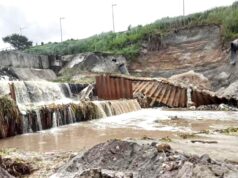MASANTOL, Pampanga- Fisherfolk here are up in arms over the destruction by the Department of Public Works and Highways (DPWH) of an anti-flood project funded from a P2.1-billion loan from Japan, allegedly in the guise of complying with a Supreme Court order to clear waterways towards the Manila Bay.
“We want a stop and a probe on the ongoing demolition of 14-kilometer secondary dikes along the Pampanga River,” said former Vice Mayor Bajun Lacap, now chair of the Coastal Emergency Response Group which local folk created amid perennial threat of natural disasters in their area.
He noted that the government is still paying for the loan for the project. “Our information is that the DWH district office succeeded in having released a P39 million funding allocation for the demolition work, so its contractors are in a hurry to finish all by yearend so that the funds do not revert to the national treasury,” Lacap said that he and his group were informed by DPWH that the ongoing demolition of the project was in compliance with a Supreme Court order in 2008 mandating government agencies, including the DPWH to clean up the Manila Bay, including inland waterways that empty into it.
“For one thing, the Pampanga Delta Development Project can’t be considered obstructions that adversely affect the Manila Bay. It was carefully studied and implemented,” he said Lacap reported that “the DPWH has already destroyed about three kilometers of the dikes and they are rushing to demolish the entire length of the project.”
He warned that if the secondary dikes are removed, the main earthen dike protecting highly populated communities here would be exposed to “life-threatening floodwaters,” as he cited Barangays Sapang Cauayan, Ligui, Sagrada Familia, Saguing, Balibago, Alauli and Candelaria as the most vulnerable areas in case of the collapse of the PDDP dikes.
The anti-flood project is under the PDDP consisting of widening the Pampanga River from merely 60 meters to a kilometer and the construction on both banks of seven-meter high earthen main dikes. These dikes are further protected by the socalled high-water channel (HWC) at their inner base which in turn is separated by a secondary 1.5-meter high secondary dike from the deeper middle of the river.
This HWC provides more space for water overflowing from the main waterway during the rainy season, while also protecting the main outerdike. During the dry season, these HWC are used by local fisherfolk as fishponds for their livelihood. The current DPWH demolition of the secondary dike would thus also remove their fishponds.
Lacap noted that when the PDDP was finished in their town, the government allowed the Masantol municipal government to lease to local fisherfolk the HWC for aquaculture. They have been leasing HWC areas for P3,000 per year.
“Most of those who were allowed to lease were those who had to give up their homes and communities to give way to the widening of the Pampanga River,” he said. PDDP records indicated that the PDDP flood control project led to the demolition of 1,851 households, 10 school buildings, 14 barangay halls, 14 chapels, and 29 deep wells.
A PDDP survey done in 2004 indicated that 69 percent of residents on the “left bank” of the Pampanga River and 78 percent of residents on the right bank “recognized decrease in the frequency of flooding” after the PDDP project here was finished.
Other components of the PDDP in Bulacan have not been finished arising from stiff protests from families who refused to give way to it in the towns of Calumpit, Hagonoy and Paombong. “If the DPWH really wants to remove obstructions in the Pampanga River towards Manila Bay, they should instead dredge the heavily silted Sapang Cauayan and widen the San Esteban cut-off channel,” Lacap said.



